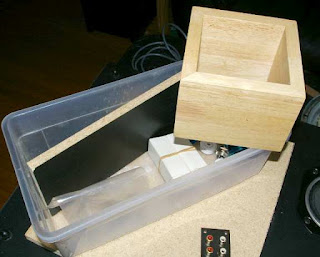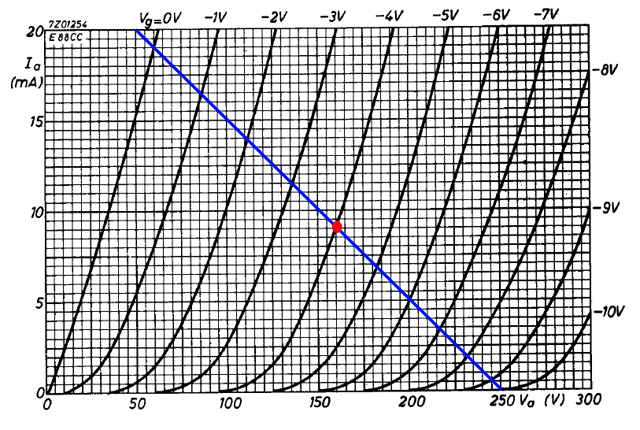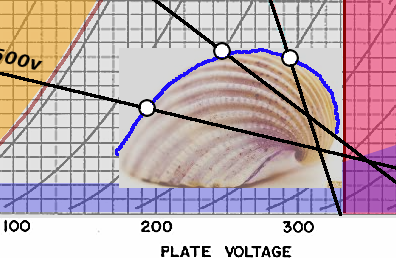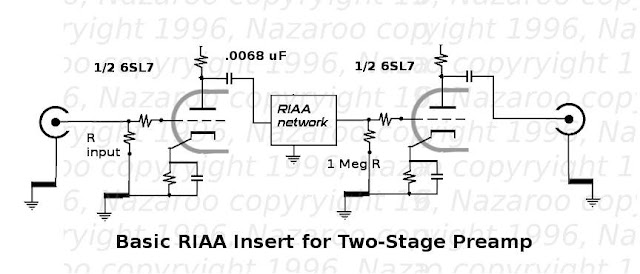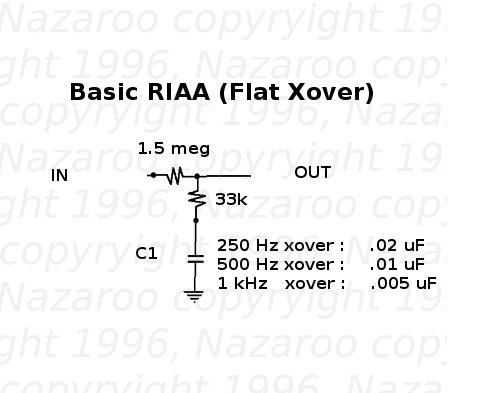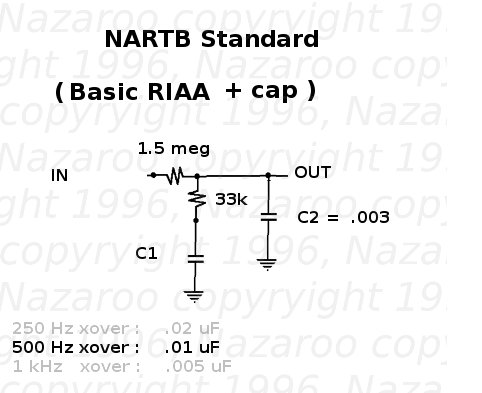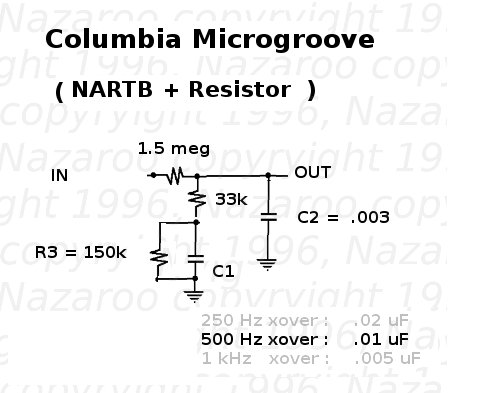RIAA Preamp Build (Part 1)
Well, someone asked me to design a low-noise stereo preamp for RIAA, (record phono input Equalization), so Challenge Accepted!
I made a preliminary design effort using a Mu-Follower type layout for dead-quiet PSRR and low noise, and also chose a low-voltage tube. I will be using either 6922s or a 6GM8. (see my other threads on Mu-Follower circuits).
Decided on separate power supply and preamp chassis, for even lower noise, because this is a really low-voltage input signal (old magnetic cartridges etc.).
I enlisted the boy to help me with the power supply. I took a standard but nice-looking metal box as a base.
The boy loves these special wire-strippers. He thinks they look like Oscar the Grouch, and calls them the "Eyebrow tool":
I happened to have a ready-made 60 volt filtered supply PCB, loaded and tested. All that was needed was a 12 vAC transformer. Well, I ordered one on Ebay (notice it says right on it TRANSFORMER). I assumed the housing was just shielding and a convenient mounting.
It turns out the Chinese still don't know how to label things properly. This turned out not to be a transformer at all, but a DC power supply containing a transformer! Who knew! Idiots.
Well, pressing on, I got some four-wire shielded cable and attached a nice solid connector to it. This will go to the preamp chassis proper. I improved the HV insulation inside the plug by weaving electrical tape between the pins.
For tagging purposes, (and additional isolation), I re-paired (no pun) the wires so that the heater (which doesn't matter is two whites, and the HV (60v) is blue/orange (-/+). Keeps things simple to hook up correctly.
Here's a sneak preview of the other half of the project: My part collection for the preamp itself. I'm using this nice knick knack box as a base, it looks really nice. It will have two tubes on it, and some RCA jacks, and a pwr connector.
Not a lot to remark on schematic-wise so far. Will discuss circuits in following posts.
Well, someone asked me to design a low-noise stereo preamp for RIAA, (record phono input Equalization), so Challenge Accepted!
I made a preliminary design effort using a Mu-Follower type layout for dead-quiet PSRR and low noise, and also chose a low-voltage tube. I will be using either 6922s or a 6GM8. (see my other threads on Mu-Follower circuits).
Decided on separate power supply and preamp chassis, for even lower noise, because this is a really low-voltage input signal (old magnetic cartridges etc.).
I enlisted the boy to help me with the power supply. I took a standard but nice-looking metal box as a base.
The boy loves these special wire-strippers. He thinks they look like Oscar the Grouch, and calls them the "Eyebrow tool":
I happened to have a ready-made 60 volt filtered supply PCB, loaded and tested. All that was needed was a 12 vAC transformer. Well, I ordered one on Ebay (notice it says right on it TRANSFORMER). I assumed the housing was just shielding and a convenient mounting.
It turns out the Chinese still don't know how to label things properly. This turned out not to be a transformer at all, but a DC power supply containing a transformer! Who knew! Idiots.
Well, pressing on, I got some four-wire shielded cable and attached a nice solid connector to it. This will go to the preamp chassis proper. I improved the HV insulation inside the plug by weaving electrical tape between the pins.
For tagging purposes, (and additional isolation), I re-paired (no pun) the wires so that the heater (which doesn't matter is two whites, and the HV (60v) is blue/orange (-/+). Keeps things simple to hook up correctly.
Here's a sneak preview of the other half of the project: My part collection for the preamp itself. I'm using this nice knick knack box as a base, it looks really nice. It will have two tubes on it, and some RCA jacks, and a pwr connector.
Not a lot to remark on schematic-wise so far. Will discuss circuits in following posts.
Well, all we need do then is review my general discussion of how to properly (and improperly) bias a 6922 tube:
Tube Biasing 101: (Part 1) Biasing a 6922
oh oh, I've seen schematics like this before,
and he's driving the 6922 too hard: taking it over its dissipation-wattage rating.
But others have also pointed out that there is nothing really to gain from that, except shortened tube life.
OK this schematic came from here:
DIY 6922 / E88CC Tube preamp
On that page you'll see his loadline for the 6922:
If you plot the Watt Dissipation line over this, you'll see the problem.
The solution is to alter the loadline (by putting a db-pad or volume pot on the output) and also the quiescent-point (idle-current) by adjusting the bias via the cathode resistor, and possibly the voltage.
The 6922 is a great tube, but it is a low-noise fragile signal tube, not meant for this kind of manhandling.
The Dot which represents the idle-spot should be well below the max-dissipation curve.
The voltage swing, which will meander over the line anyway, should never spend more than half its time outside the boundaries.
Although Philips allows 2 watts dissipation / triode,
The Telefunken sets 1.5 watts as the real limit. Obviously we go with the lower rating.
Also, it is generally recommended that your design stay at 70% of max wattage rating for safety and to allow for variation between tubes and brands.
Here's a better loadline and bias0-point for the 6922.
It sits at 70% of the conservative max dissipation (1 watt).

With this new bias-point you stay in 70% zone, and tube stays out of trouble most of its life.
The load resistor becomes about 12k5, the cathode resistor is 830 ohms, the bias voltage is -5.
The cathode floats about 150 volts above ground.
The tube coasts in its comfy spot, with very little loss of headroom and great gains in tube longevity.
Tube Charts without Heat-dissipation and max rating boundaries are almost useless for setting tube loads and bias points.
Tube Biasing 101: (Part 1) Biasing a 6922
oh oh, I've seen schematics like this before,
and he's driving the 6922 too hard: taking it over its dissipation-wattage rating.
But others have also pointed out that there is nothing really to gain from that, except shortened tube life.
OK this schematic came from here:
DIY 6922 / E88CC Tube preamp
On that page you'll see his loadline for the 6922:
If you plot the Watt Dissipation line over this, you'll see the problem.
The solution is to alter the loadline (by putting a db-pad or volume pot on the output) and also the quiescent-point (idle-current) by adjusting the bias via the cathode resistor, and possibly the voltage.
The 6922 is a great tube, but it is a low-noise fragile signal tube, not meant for this kind of manhandling.
The Dot which represents the idle-spot should be well below the max-dissipation curve.
The voltage swing, which will meander over the line anyway, should never spend more than half its time outside the boundaries.
Although Philips allows 2 watts dissipation / triode,
The Telefunken sets 1.5 watts as the real limit. Obviously we go with the lower rating.
Also, it is generally recommended that your design stay at 70% of max wattage rating for safety and to allow for variation between tubes and brands.
Here's a better loadline and bias0-point for the 6922.
It sits at 70% of the conservative max dissipation (1 watt).

With this new bias-point you stay in 70% zone, and tube stays out of trouble most of its life.
The load resistor becomes about 12k5, the cathode resistor is 830 ohms, the bias voltage is -5.
The cathode floats about 150 volts above ground.
The tube coasts in its comfy spot, with very little loss of headroom and great gains in tube longevity.
Tube Charts without Heat-dissipation and max rating boundaries are almost useless for setting tube loads and bias points.
For those who want more on how exactly to set the loadline, bias, and quiescent point of a tube, I'll repost my 12AX7 example too:
What you need really is my ideal Bias point chart:
This is the Bermuda Triangle of Tube Biasing:

There is really no single ideal bias setup,
however, you can intelligently select operating points and ranges based on intended use.
Here are some examples:
(1) Hi-Fi setup: High Voltage B+ (500v) and Large Load (420k), to minimize distortion and maximize voltage transfer to load (this is not a power circuit, so voltage is more important than power transfer efficiency). Although higher voltages raise risks, they give more horizontal loadlines, which means current remains stable (think CCS). Headroom is not paramount here, because typical input signals will be played at low to mid-level volumes, to further limit system distortion, and protection against high voltage swings can be built in via -db pads for input of stage.
A lower bias point is selected, to better center swing in zone of maximum linearity.
(2) Universal Soldier Setup: Slightly Higher Voltage B+ (400 v range) Here is the mid-zone. Reasonable voltage and current excursion is expected, and more current can give both stability and a current source for subsequent stages which might need draw. a bias-point of -2v gives a nice centering for a balance of headroom and linearity.
(3) Guitar Maniac Setup: Here overloading is expected and harmonic distortion (non-linearity) is actually desired. Lower plate load gives a nice steep 'dive-bomb' loadline, while lower plate voltage (330 B+) protects tube from HV shorting, and allows pushing tube into cut-off safely. The higher bias point (-2.5 to even 3.5) is chosen to give maximum headroom for wild guitar antics and easy sliding into non-linear 'sweet-spots', without driving tube into grid-conduction, which is a non-musical type of distortion.
One thing that many people will notice, is that a large number of circuits load and bias 12AX7s nowhere near the design-center Triangle depicted above.
It will be a good exercise in fact to take both your favorite circuits (and your notorious pet peeves) and put them on my chart, to see how and where they are screwing up.
As I maintained in another thread, few people know how to properly set up a tube for the intended purpose.
Some things to observe:
(1) proper bias and setup is first dictated by intended use of the circuit. This must be nailed down first.
(2) Next, appropriate B+ voltages and loads are chosen, to fix the slope and position of the load line.
(3) Now, the bias-point is selected based on the balance desired between headroom/input range and non-linearity/harmonic distortion.
(4) To force the bias-point, the correct self-biasing cathode resistor is chosen, or better, several tubes are set up in a rig, and the resistor is selected by experiment to put the bias-point in the best compromise position between the acceptable range of tube samples.
(5) The performance of the circuit is tested under realistic conditions, including input signals, and output loads from following stages. Attenuation or amplification is adjusted at the input, and impedance matching is done at the output, to conform to expected conditions.
Finally, notice that the ideal bias-point slides along the load-line to the left, as the load-line tilts toward horizontal and slides to the right. The Bias Point traces the beautiful mathematical curve known as the sea-shell spiral:
What you need really is my ideal Bias point chart:
This is the Bermuda Triangle of Tube Biasing:

There is really no single ideal bias setup,
however, you can intelligently select operating points and ranges based on intended use.
Here are some examples:
(1) Hi-Fi setup: High Voltage B+ (500v) and Large Load (420k), to minimize distortion and maximize voltage transfer to load (this is not a power circuit, so voltage is more important than power transfer efficiency). Although higher voltages raise risks, they give more horizontal loadlines, which means current remains stable (think CCS). Headroom is not paramount here, because typical input signals will be played at low to mid-level volumes, to further limit system distortion, and protection against high voltage swings can be built in via -db pads for input of stage.
A lower bias point is selected, to better center swing in zone of maximum linearity.
(2) Universal Soldier Setup: Slightly Higher Voltage B+ (400 v range) Here is the mid-zone. Reasonable voltage and current excursion is expected, and more current can give both stability and a current source for subsequent stages which might need draw. a bias-point of -2v gives a nice centering for a balance of headroom and linearity.
(3) Guitar Maniac Setup: Here overloading is expected and harmonic distortion (non-linearity) is actually desired. Lower plate load gives a nice steep 'dive-bomb' loadline, while lower plate voltage (330 B+) protects tube from HV shorting, and allows pushing tube into cut-off safely. The higher bias point (-2.5 to even 3.5) is chosen to give maximum headroom for wild guitar antics and easy sliding into non-linear 'sweet-spots', without driving tube into grid-conduction, which is a non-musical type of distortion.
One thing that many people will notice, is that a large number of circuits load and bias 12AX7s nowhere near the design-center Triangle depicted above.
It will be a good exercise in fact to take both your favorite circuits (and your notorious pet peeves) and put them on my chart, to see how and where they are screwing up.
As I maintained in another thread, few people know how to properly set up a tube for the intended purpose.
Some things to observe:
(1) proper bias and setup is first dictated by intended use of the circuit. This must be nailed down first.
(2) Next, appropriate B+ voltages and loads are chosen, to fix the slope and position of the load line.
(3) Now, the bias-point is selected based on the balance desired between headroom/input range and non-linearity/harmonic distortion.
(4) To force the bias-point, the correct self-biasing cathode resistor is chosen, or better, several tubes are set up in a rig, and the resistor is selected by experiment to put the bias-point in the best compromise position between the acceptable range of tube samples.
(5) The performance of the circuit is tested under realistic conditions, including input signals, and output loads from following stages. Attenuation or amplification is adjusted at the input, and impedance matching is done at the output, to conform to expected conditions.
Finally, notice that the ideal bias-point slides along the load-line to the left, as the load-line tilts toward horizontal and slides to the right. The Bias Point traces the beautiful mathematical curve known as the sea-shell spiral:
Mu-follower circuits have been well discussed, ... so I will leave the basic circuit to one side for now, and discuss RIAA.
We may note in passing that in the evolution of music recording, various media and techniques were developed, each with its own problems, side-effects and equalization requirements.
The main problem with recording was the limitation and the skewedness of the frequency response.
An ideal frequency response would be similar to that claimed for a modern stereo amp:
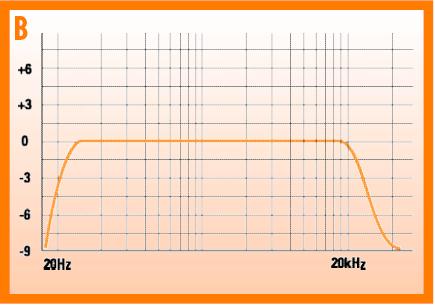
However, the actual process of recording would imprint its own frequency response 'fingerprint' or bias. Thus a magnetic phono record response curve might look more like this:

That is, in the process of recording, the final product (a vinyl record and playback needle) has very loud treble, and very little bass.
As a result, the signal needs heavy correction or 'equalization' to restore the sound back to how it originally sounded. Thus the "equalizer" was originally a correction device in the playback chain to compensate for frequency response distortion in the recording and playback media chain.
The "Equalization" is imposed in the preamp stage, just after the signal is retrieved from the record through the magnetic cartridge. Like an adjustable tone control, this circuit imposes its own curve on the signal:

The two filtering processes (recording and playback) are supposed to cancel each other out, restoring the signal to its original balance, and achieving a more or less flat frequency response overall.
As a matter of history, early attempts at equalization had some variations, before some semblance of standardization sorted itself out in the marketplace, and in the interim, several hi-fi equipment makers offered alternate settings to more closely accommodate various recordings the methods used. The McIntosh AE-2 (pre)amplifier Equalizer control (1950) for instance offered both a 5-position switch and bass and treble adjustments:
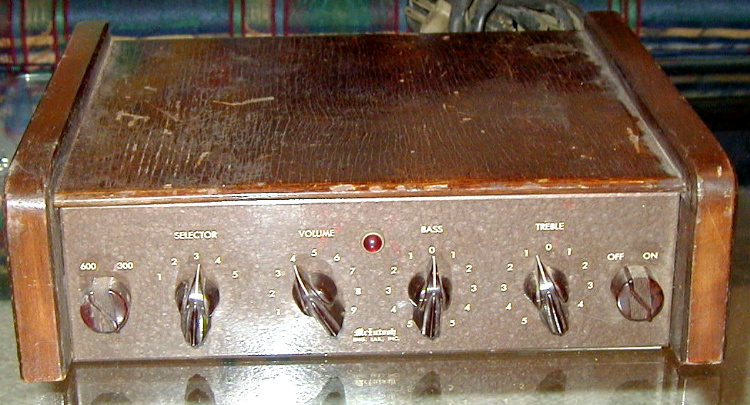
Today, an RIAA equalization circuit is usually a simplified version (a compromise) of the various EQ curves and standards floating about in the 50s and 60s. It is assumed that most stereo systems will have some kind of 'fine tuning' tone-control adjustments, so that specialized RIAA circuits for each case are not really needed.
Those who are serious about playing back their vinyl records as they were really intended, and with the best fidelity however, will not be satisfied with such commercial compromises, and will want to have a selection of RIAA equalization circuits at hand for playing various records.
In terms of the variations, the following main cases are:
(1) the Columbia 78 rpm circuit
(2) the Columbia 33.3
(3) the RCA Victor 78 and 45 rpm,
(4) the RCA Victor 33.3, and Concert Hall 78 versions.
(4) the London (records) FFRR and Decca FFRR.
These are the most used and most popular versions.
If you have a swelling vinyl collection, it might be wise to do some sorting or labeling on the basis of the RIAA type or equalization needed.
The brand-names and dating will go a long way toward sorting out the issues.
We may note in passing that in the evolution of music recording, various media and techniques were developed, each with its own problems, side-effects and equalization requirements.
The main problem with recording was the limitation and the skewedness of the frequency response.
An ideal frequency response would be similar to that claimed for a modern stereo amp:

However, the actual process of recording would imprint its own frequency response 'fingerprint' or bias. Thus a magnetic phono record response curve might look more like this:

That is, in the process of recording, the final product (a vinyl record and playback needle) has very loud treble, and very little bass.
As a result, the signal needs heavy correction or 'equalization' to restore the sound back to how it originally sounded. Thus the "equalizer" was originally a correction device in the playback chain to compensate for frequency response distortion in the recording and playback media chain.
The "Equalization" is imposed in the preamp stage, just after the signal is retrieved from the record through the magnetic cartridge. Like an adjustable tone control, this circuit imposes its own curve on the signal:

The two filtering processes (recording and playback) are supposed to cancel each other out, restoring the signal to its original balance, and achieving a more or less flat frequency response overall.
As a matter of history, early attempts at equalization had some variations, before some semblance of standardization sorted itself out in the marketplace, and in the interim, several hi-fi equipment makers offered alternate settings to more closely accommodate various recordings the methods used. The McIntosh AE-2 (pre)amplifier Equalizer control (1950) for instance offered both a 5-position switch and bass and treble adjustments:

Today, an RIAA equalization circuit is usually a simplified version (a compromise) of the various EQ curves and standards floating about in the 50s and 60s. It is assumed that most stereo systems will have some kind of 'fine tuning' tone-control adjustments, so that specialized RIAA circuits for each case are not really needed.
Those who are serious about playing back their vinyl records as they were really intended, and with the best fidelity however, will not be satisfied with such commercial compromises, and will want to have a selection of RIAA equalization circuits at hand for playing various records.
In terms of the variations, the following main cases are:
(1) the Columbia 78 rpm circuit
(2) the Columbia 33.3
(3) the RCA Victor 78 and 45 rpm,
(4) the RCA Victor 33.3, and Concert Hall 78 versions.
(4) the London (records) FFRR and Decca FFRR.
These are the most used and most popular versions.
If you have a swelling vinyl collection, it might be wise to do some sorting or labeling on the basis of the RIAA type or equalization needed.
The brand-names and dating will go a long way toward sorting out the issues.
Last edited:
RIAA circuits 101
We could get into an extended discussion of RIAA equalization and its history, but why bother? This would be overkill for the average DIYer.
All we really need is the basic overview, and some idea of how to successfully integrate standard and practical circuits into our preamp. No point in re-inventing the wheel.
So lets skip the worst of the technical questions and complex equations for filter networks, and look at some real-world examples, which we can modify for our purposes.
First of all, the overview:
It is generally best to either do the EQing after the first stage of amplification, or between two stages in the signal path, so we can gain the headroom needed and control the results of our efforts.

Since we will probably only have a single stage, our RIAA network will come afterward, once the signal is amplified.
We could get into an extended discussion of RIAA equalization and its history, but why bother? This would be overkill for the average DIYer.
All we really need is the basic overview, and some idea of how to successfully integrate standard and practical circuits into our preamp. No point in re-inventing the wheel.
So lets skip the worst of the technical questions and complex equations for filter networks, and look at some real-world examples, which we can modify for our purposes.
First of all, the overview:
It is generally best to either do the EQing after the first stage of amplification, or between two stages in the signal path, so we can gain the headroom needed and control the results of our efforts.

Since we will probably only have a single stage, our RIAA network will come afterward, once the signal is amplified.
RIAA Preamp Build (part 4): 2-stage standard
Lets look at a basic 2-stage RIAA preamp from the early 50s.
As expected, the RIAA EQ will be inserted after the first stage, where headroom can be found and behavior controlled.
There are actually two parts to the circuit in regards to phono cartridges.
(1) The Input Impedance of the Unit. (R in). This will be set to 16K for ceramic cartridges, and otherwise, for magnetic cartridges, it should match that specified by the maker of the cartridge. Thus you could have a couple of resistors here to switch in and out depending upon the cartridge you were using, or a Ceramic/Magnetic setting.
(2) The RIAA Network Proper. This is a 3-terminal (in/out/ground) interchangeable or adjustable network, activated by selection switches. Note the pre-specified .0068 uF input cap, and the 1 Meg output load to the next stage. These are chosen as a base for the variations to follow.
Circuit Operation:
The 6SL7 is chosen for its high Mu (gain). With all high Mu triodes, care should be taken to prevent HF rolloff from Miller capacitance. Here with a gain of 30 and a MC in the order of 100 uuFd, the output Z of the source shouldn't be higher than 75K to keep the 3db point above 20kHz. Luckily both ceramics and magnetics generally have Out Z lower than this.
We now design the Out Z of the RIAA circuit etc. to keep the signal to stage 2 low in size (and distortion). The EQ circuit will have an Amplification factor of .022 at 1kHz, even at 20 Hz the Amplificatoin (after losses) will be only about .33. This means you can have a bias as low as -2 volts on the 2nd stage, and a typical input signal of .1 volt to the first stage.
1K R Cathode resistors will typically be bypassed with a 47 uF cap to keep up the gain and most importantly to reduce heater hum. To keep the signal clean, this (electrolytic) can itself be bypassed with a small polypropolene for signal clarity, slew-rate and reduced noise.
In these low-signal circuits you need a really good, well filtered Power Supply. In my view this makes the Mu-Follower the ideal method for supplying the HV.
Design of the RIAA Circuit (EQ):
(1) First, the input Z which the first stage sees must be high enough not to load the tube too much, (which would cause distortion).
(2) Second, the Out Z presented to the 2nd stage should be low enough not to lose high end through Miller Capacitance.
(3) Finally, if you have more than one RIAA circuit, they should be matched in overall attenuation losses so you can switch easily between settings without volume problems.
Flat Turnover EQ:
A basic L-circuit does the trick for flat recordings with a fixed turn-over point (i.e., where the gain is about 0 db).
(A) 250 Hz Flat Xover: For British H.M.V. and other European pressings (Mittell, B.E.B., etc)
(B) 500 Hz Flat Xover: Older American Vintage pressings.
(C) 1 kHz Flat Xover: Some rare European recordings.
Lets look at a basic 2-stage RIAA preamp from the early 50s.
As expected, the RIAA EQ will be inserted after the first stage, where headroom can be found and behavior controlled.
There are actually two parts to the circuit in regards to phono cartridges.
(1) The Input Impedance of the Unit. (R in). This will be set to 16K for ceramic cartridges, and otherwise, for magnetic cartridges, it should match that specified by the maker of the cartridge. Thus you could have a couple of resistors here to switch in and out depending upon the cartridge you were using, or a Ceramic/Magnetic setting.
(2) The RIAA Network Proper. This is a 3-terminal (in/out/ground) interchangeable or adjustable network, activated by selection switches. Note the pre-specified .0068 uF input cap, and the 1 Meg output load to the next stage. These are chosen as a base for the variations to follow.
Circuit Operation:
The 6SL7 is chosen for its high Mu (gain). With all high Mu triodes, care should be taken to prevent HF rolloff from Miller capacitance. Here with a gain of 30 and a MC in the order of 100 uuFd, the output Z of the source shouldn't be higher than 75K to keep the 3db point above 20kHz. Luckily both ceramics and magnetics generally have Out Z lower than this.
We now design the Out Z of the RIAA circuit etc. to keep the signal to stage 2 low in size (and distortion). The EQ circuit will have an Amplification factor of .022 at 1kHz, even at 20 Hz the Amplificatoin (after losses) will be only about .33. This means you can have a bias as low as -2 volts on the 2nd stage, and a typical input signal of .1 volt to the first stage.
1K R Cathode resistors will typically be bypassed with a 47 uF cap to keep up the gain and most importantly to reduce heater hum. To keep the signal clean, this (electrolytic) can itself be bypassed with a small polypropolene for signal clarity, slew-rate and reduced noise.
In these low-signal circuits you need a really good, well filtered Power Supply. In my view this makes the Mu-Follower the ideal method for supplying the HV.
Design of the RIAA Circuit (EQ):
(1) First, the input Z which the first stage sees must be high enough not to load the tube too much, (which would cause distortion).
(2) Second, the Out Z presented to the 2nd stage should be low enough not to lose high end through Miller Capacitance.
(3) Finally, if you have more than one RIAA circuit, they should be matched in overall attenuation losses so you can switch easily between settings without volume problems.
Flat Turnover EQ:
A basic L-circuit does the trick for flat recordings with a fixed turn-over point (i.e., where the gain is about 0 db).
(A) 250 Hz Flat Xover: For British H.M.V. and other European pressings (Mittell, B.E.B., etc)
(B) 500 Hz Flat Xover: Older American Vintage pressings.
(C) 1 kHz Flat Xover: Some rare European recordings.
RIAA Preamp Build (part 5): Extras
Now lets take the basic RIAA (Flat Xover),
and form two more of the most popular EQs:
(D) The NARTB Standard: (Artist, Capitol, M.G.M., and many other American pressings) = (C) The 500 Hz Flat Xover + a cap:
and finally,
(E) The Columbia Microgroove: (NARTB + a resistor):
We can also squeeze out the RCA Victor 78 rpm EQ from a basic RIAA (flat 500), by adding an additional L-network, but after this we have to start from scratch to punch out the last two, (Decca FFRR, and Columbia 78 std.), because they require more extensive changes.
Now lets take the basic RIAA (Flat Xover),
and form two more of the most popular EQs:
(D) The NARTB Standard: (Artist, Capitol, M.G.M., and many other American pressings) = (C) The 500 Hz Flat Xover + a cap:
and finally,
(E) The Columbia Microgroove: (NARTB + a resistor):
We can also squeeze out the RCA Victor 78 rpm EQ from a basic RIAA (flat 500), by adding an additional L-network, but after this we have to start from scratch to punch out the last two, (Decca FFRR, and Columbia 78 std.), because they require more extensive changes.
RIAA Preamp (part 6):
Here are the last useful RIAA EQs:
(G) Columbia 78 rpm
(F) RCA 78 rpm
(H): Decca FFRR

Note that with the last (Decca FFRR), only the lower left cap is the same, and this is best made up as a separate network.
DIYers are now free to choose the most useful combinations for their collection and setup.
These networks can be used in almost any preamp design, that conforms reasonably closely to our basic two-stage circuit (the impedances are the most critical element here).
Its best not to try to copy Solid-state versions of RIAA networks, as they usually involve feedback loops (which are not always obvious).
Here are the last useful RIAA EQs:
(G) Columbia 78 rpm
(F) RCA 78 rpm
(H): Decca FFRR

Note that with the last (Decca FFRR), only the lower left cap is the same, and this is best made up as a separate network.
DIYers are now free to choose the most useful combinations for their collection and setup.
These networks can be used in almost any preamp design, that conforms reasonably closely to our basic two-stage circuit (the impedances are the most critical element here).
Its best not to try to copy Solid-state versions of RIAA networks, as they usually involve feedback loops (which are not always obvious).
Last edited:
- Status
- This old topic is closed. If you want to reopen this topic, contact a moderator using the "Report Post" button.
- Home
- Amplifiers
- Tubes / Valves
- RIAA Tube Preamp Build (Part 1)




